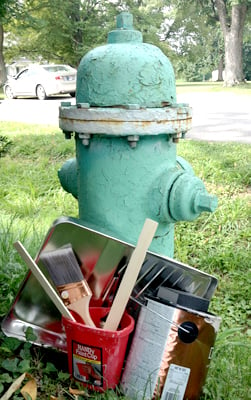 Forbes Magazine reports that you only have 7 seconds to make a good first impression. Whether it’s your home or personal appearance, we usually try to make that first impression a memorable one. Appearances are important to your community also; one way to give a better “first impression” is to properly maintain your fire hydrants.
Forbes Magazine reports that you only have 7 seconds to make a good first impression. Whether it’s your home or personal appearance, we usually try to make that first impression a memorable one. Appearances are important to your community also; one way to give a better “first impression” is to properly maintain your fire hydrants.
Do you have fire hydrants in your community that are old and outdated? Peeling paint? Inoperable?
Your community’s fire hydrants are a significant public water infrastructure component, and they are one of the first things people see when driving in your community. Ensuring they are clearly visible and well maintained will help protect residents and business owners from extended loss by a fire event and give visitors and potential residents a sense of safety and comfort. Insurance discounts for fire hydrants that are appropriately spaced and working are also available for your community and its water users.
Follow these tips to maintain your community’s fire hydrants and to make that first impression a good one.
PAINTING HYDRANTS
Color
For hydrants installed before 2009, consider using a color that will be visible under adverse light and weather conditions, such as “Safety Yellow” manufactured by Rustoleum.
Coating
Do you have hydrants in your community’s water distribution system that were installed after 2009? In 2010, fire Hydrant manufacturers started to top coat their hydrants with a 2-part polyurethane enamel paint that is applied to the hydrant by a hydrostatic process for a long lasting and durable finish. This paint is a very hard, light-resisting coating that cannot be re-coated within the field with a standard gloss enamel paint. In order to recoat the hydrant (if needed), the surface must first be cleaned and sanded to remove the “shiny” appearance of the polyurethane enamel paint. After completing the required surface preparation, re-coat with a polyurethane enamel, such as Sherwin Williams Polane SP. Mueller Company's instructions on how to re-coat hydrants with a hydrostatically applied coating can be found here.
EXERCISING HYDRANTS
To ensure the functionality of your hydrants is maintained, you will want to perform hydrant flow testing. Regularly opening and closing the auxiliary gate valves on your hydrants will help to provide:
- A reliable source of water when it is needed for fire events by your local fire department.
- An indication of the amount of flow and pressure available at each respective hydrant in your community’s water distribution system. This information is beneficial for water service planners and your local fire authority.
Some items to keep in mind when performing hydrant flow testing:
- Establish a schedule for testing a third of your water system hydrants each year.
- Choose a safe area to direct flow; water flowing out of a hydrant can significantly damage landscaping, vegetation, private property, and even structures.
- Slowly open and close the hydrant valves to prevent water hammer, which can cause breaks in the water mains.
Because it is costly to replace fire hydrants in a water distribution system, it is imperative to establish a proper maintenance and exercising schedule for hydrants. Remember, you don’t have to be a professional to spruce up your hydrant with a fresh coat of paint. Many communities seek volunteers from local organizations or students to take on this task. Although it is inevitable that a fire hydrant will eventually need to be fixed or replaced, proper maintenance will prolong the life of your hydrants.
Does your community project a positive first impression? Will your citizens and visitors be impressed with how well you maintain your assets, and will they feel properly protected? Try looking at your community through the eyes of a visitor and see if your perspective is different.
Tags

